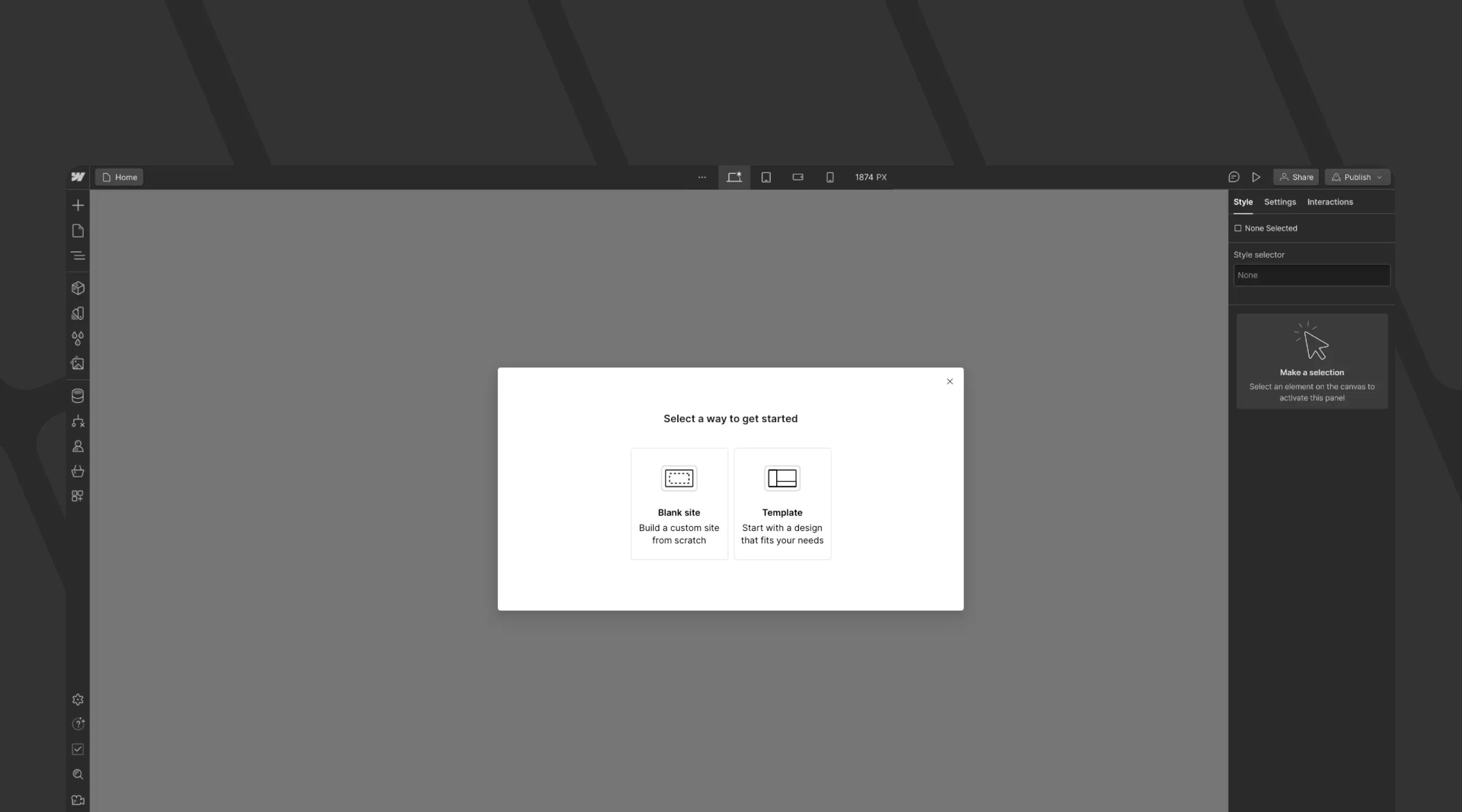How to Better Yourself as a Web Designer: 10 Actionable Tips
Enhance your skills as a web designer with these actionable tips — covering UX best practices, Webflow, animations, and coding — to succeed in Singapore.

How to Better Yourself as a Web Designer: A Guide to Continuous Growth
Web design is an ever-evolving field, and staying ahead of the curve requires constant learning and adaptation. Whether you're a solo designer or part of a web design agency in Singapore, the journey to becoming a better web designer is both challenging and rewarding. In this article, we’ll explore practical steps you can take to refine your craft, with a focus on website design, Webflow, and cutting-edge techniques.
Let’s dive into actionable tips and strategies to help you grow as a web designer.
1. Keep Creating Website After Website
The first step to improving as a web designer is simple: practice. The more websites you create, the more you’ll refine your skills and discover your unique style.
Tips for Effective Practice:
- Set personal projects: Challenge yourself to design websites for fictional brands or redesign existing ones. This allows you to experiment without client constraints.
- Focus on variety: Try designing for different industries — e-commerce, portfolios, blogs etc. This will broaden your skill set and make you more versatile.
- Track your progress: Save every project you work on. Over time, you'll see how far you've come, which is incredibly motivating.
2. Understand Why Animations and Interactions Are Being Used
Animations and interactions are no longer just “nice-to-haves” — they’re essential for creating engaging, modern websites. Platforms like YouTube are treasure troves of tutorials on everything from subtle hover effects to complex scroll-triggered animations.
Tips for Mastering Animations:
- Start small: Begin with basic CSS animations before moving on to Javascript or Webflow Interactions.
- Follow industry leaders: Channels on Youtube like Flux Academy offer excellent resources for web designers.
- Experiment freely: Use tools like Webflow's built-in interaction designer to test and tweak animations in real-time.
By incorporating animations into your website design, you can create a more dynamic user experience that keeps visitors engaged.
3. Recreate Animations and Interactions on Your Website
Once you’ve learned the basics, the next step is to recreate animations and interactions you admire. This hands-on approach helps you understand the mechanics behind them and builds your problem-solving skills.
Tips for Recreating Animations:
- Break it down: Analyse the animation step-by-step. What triggers it? How does it transition?
- Use Webflow: Webflow's visual interface makes it easy to experiment with interactions without writing code.
- Iterate and Improve: Don't stop at replication; add your own twist to make it unique.
For web design agencies in Singapore, showcasing custom animations can set your work apart in a competitive market.
4. Look at UX Best Practices for Web Design and Apply Them!
User experience (UX) is the backbone of any successful website. By following UX best practices, you can create designs that are not only visually appealing but also intuitive and user-friendly.
Tips for Applying UX Best Practices:
- Prioritise accessibility: Ensure your designs are accessible to all users, including those with disabilities.
- Simplify navigation: A clean, easy-to-use navigation menu enhances the user experience.
- Test with real users: Conduct usability tests to identify pain points and areas for improvement.
For website design projects, a strong focus on UX can lead to higher conversion rates and happier clients.
5. Learn Some Coding Skills!
While no-code tools like Webflow have revolutionised web design, having a basic understanding of coding can give you an edge. JavaScript, in particular, is invaluable for adding interactivity to your designs.
Tips for Learning Javascript:
- Start with the basics: Learn fundamental concepts like variables, functions and event listeners.
- Use interactive platforms: Websites like Codecademy and freeCodeCamp offer hands-on coding exercises.
- Apply your knowledge: Try adding custom javascript snippets to your Webflow projects for advanced functionality.
Even if you’re part of a web design agency in Singapore, knowing how to code can help you collaborate more effectively with developers.
6. Stay Updated with Design Trends
The world of web design is constantly changing, and staying updated is crucial. Follow design blogs, attend webinars, and explore new tools to keep your skills fresh.
Tips for Staying Updated:
- Follow design blogs: Follow design blogs that will keep you inspired and motivated to learn new things.
- Experiment with new tools: Try emerging top tools like Spline to expand your toolkit.
- Join communities: Engage with other designers such as Dribbble or even Threads!
For web design agencies in Singapore, staying ahead of trends can help you offer cutting-edge solutions to clients.
7. Collaborate with Other Designers & Developers
Collaboration is a powerful way to learn and grow. Working with others exposes you to new perspectives and techniques.
Tips for Effective Collaboration:
- Join design sprints: Participate in hackathons or design sprints to work on projects with others.
- Seek feedback: Share your work with peers and be open to constructive criticism.
- Learn from developers: Understanding how developers implement your designs can improve your workflow.
For website design projects, collaboration can lead to more polished and innovative results.
8. Focus on Performance Optimisation
A beautiful website is useless if it’s slow. Performance optimisation is a critical skill for modern web designers.
How to optimise your website's performance:
- Compress images: Use tools like TinyPNG to reduce image file sizes without sacrificing quality.
- Minify code: Remove unnecessary characters from your HTML, CSS, and JavaScript files.
- Leverage Webflow's features: Use Webflow’s built-in optimisation tools to streamline your site’s performance.
For web design agencies in Singapore, fast-loading websites can improve client satisfaction and SEO rankings.
9. Build a Personal Brand as a Web Designer
Your personal brand is your reputation in the industry. Building a strong brand can open doors to new opportunities and clients.
Tips for building your brand:
- Showcase your work: Create a portfolio of website designs built in Webflow.
- Share your knowledge: Write blog posts or create tutorials to establish yourself as a thought leader.
- Network actively: Attend industry events and connect with other professionals.
For freelancers in website design, a strong personal brand can help you stand out in a crowded market.
10. Never Stop Learning
The most successful web designers are lifelong learners. Embrace curiosity and always seek to expand your knowledge.
Tips for continous learning:
- Take online courses: Platforms like Udemy and Coursera offer courses on everything from UX design to advanced coding.
- Read books: Books like "Don't Make Me Think by Steve Krug" are essential reads for web designers.
- Experiment constantly: Try new techniques and tools to keep your skills sharp.
Final Thoughts
Becoming a better web designer is a journey, not a destination. By following these tips — whether you’re a solo designer or part of a web design agency in Singapore — you can continuously improve your craft and stay ahead in the competitive world of website design.
Remember, tools like Webflow are here to make your life easier, but your creativity and dedication are what truly set you apart. Keep learning, keep experimenting, and most importantly, keep designing.
By incorporating these strategies into your workflow, you’ll not only enhance your skills but also deliver exceptional results for your clients. Happy designing!
{{download-webflow-checklist="/directory"}}
Related Articles

How Schema Markup Improves CTR and Search Visibility
Discover how Schema Markup transforms your website into a rich, clickable experience. Learn to speak AI’s language, enhance SERP visibility, and attract more clicks.

5 Key Things to Do Before Building in Webflow
Learn 5 key prep steps for designers before building websites in Webflow, tailored for Singapore.

6 Proven SEO Tips to Improve Your Website Ranking
Discover 6 proven SEO strategies to improve your Google rankings, drive traffic, and grow your business in Singapore’s digital market.
Launch Your Next Website.
Ready to elevate your online presence with a trusted web design agency in Singapore?

